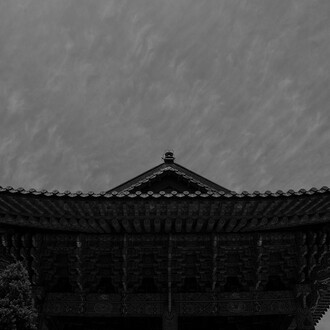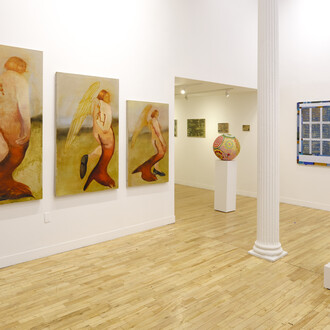The “moon jar” is a distinctive type of porcelain vessel from the late Joseon period (1392– 1897). The moon jar (viz., dalhangari) is so called due of its form, which was traditionally made by adjoining two hemispherical halves. The joined halves often come to evoke full moons themselves, beaming and blossoming into a mereological whole more sumptuous than their disparate pieces. Kwan Jin Oh's "Emptying and Filling", brimming with paintings of moon jars, is unique for myriad reasons, not least of all the jars’ speckled, toothed chips of paint. This is a notable painterly technique worthy of some analysis à la art history. Consider the extant 16th century Cranach workshop renderings of the Judgment of Paris, each of which similarly contain such ripples of dappled paint squares—these have been earned over time, with art restorers choosing to allow the works to age, chronicling their years. When we look at such works, we are immediately, affectively, and resolutely aware of their status as aged vehicles. But Oh’s paintings, themselves, are new, the earliest painting in this series from 2017. This being a painterly penchant to impute the adorned vessels with a kind of wisdom beyond the medium’s intrinsic nature, Oh has chosen to remind us that the moon jars are relics. The ceramic jars are alighted with life: they appear to swell and heave in these paintings. The vessels are truly expertly painted, the blush-auburn handles adumbrated against a flat, light-teal foreground. Oh also employs myriad techniques in his works, bringing representational figuration into conversation with abstraction. An impressionistically painted series of bright, pink buds swoop in serpentine fashion, a charcoal-dotted branch disappearing against a bright white orb to the upper right of the canvas. The moon metaphor is here doubled, but stylistically the artist has chosen to give us dimensionality on the one hand and flatness on the other. Oh’s use of flatness against veridical dimensionality truly distinguishes him from contemporaries who so often veer from poetic whimsy and indulgence.
The moon jars threaten to jump out of the canvas, almost photo-realistically painted. There is no question that Oh has proven himself as a talented artist, beyond capable of producing verisimilitude. Hence why going beyond mere studies of jars and artifacts into poetry is the next challenge, and one that the artist meets with fortitude. In one of my very favorite works, two azure birds are perched on the base of the ceramic piece, a twig branching out, their beaks folding into one another. The birds appear to be at play. This could almost be a study of birds copied from nature, as the details of every element are incisively captured. But then the birds are refracted onto the cracked moon’s sun-lit body, prodding us out of the world of figuration and into the media-at-hand: the world of the vessel. For it is, indeed, the vessel that is the central motif in Oh’s works, and these vessels are where the aforementioned cracks and teethed tatters ripple. This repeated choice to return to the being of the vessel means that Oh is not feigning aged paintings beyond their years, imitating the wilting of 16th century Cranachs, but examining how artifacts’ being aged anchors their historical sonority. Just as figuration and abstraction are dovetailed, antiquities and contemporary motifs are brought into a mutual relation.
In his recent excellent New York Review of Books review, "Between Abstraction and Representation", Jed Perl, by my lights one of the numbered genuinely brilliant living art critics, notes that artists like Julie Mehretu have recently attempted to bring elements of abstraction into play with figurative elements, albeit without committing to either mode with vigor. Often, any meaning such “abstract-cum-figurative” works impute requires exegetical intervention—perhaps a title which tells us that Mehretu's squares are stand-ins for "squares where political confrontations have taken place, including Tiananmen Square in Beijing, Red Square in Moscow, Plaza de la Revolución in Havana, and Meskel Square in Addis Ababa, where she [Mehretu] was born and spent her earliest years." Mehretu tell us that her paintings are architectural surveys that pluck from both the great masters of figuration and the twentieth century bulwarks of abstraction but, like Perl, I find myself lost in navigating their meaning. Granted, painting need not always articulate meaning as such—sometimes, the success of a painting subsists on a somatic, affective, phenomenological register. But worse yet, I find myself unaffected by Mehretu’s works, which I find close cousins of what Walter Robinson famously called “zombie formalist” painting—i.e., abstract paintings churned out alongside a coeval over-eager art market. Robinson describes “zombie formalist” paintings as follows:
"Formalism” because this art involves a straightforward, reductive, essentialist method of making a painting (yes, I admit it, I’m hung up on painting), and “Zombie” because it brings back to life the discarded aesthetics of Clement Greenberg, the man who championed Jackson Pollock, Morris Louis, and Frank Stella’s “black paintings,” among other things.
However, I disagree that it is Greenbergian medium-specificity that is revived, for Greenberg—contra the (mis)readings unspooled by the likes of Krauss, Fried, and Fer, amongst others—is genuinely a theorist of the affective, as evinced by Greenberg’s notion of “at-onceness”, outlined in “The Case for Abstract Art” (1959). Greenberg here writes:
When a picture presents us with an illusion of real space, there is all the more inducement for the eye to do […] wandering […] the whole of a picture should be taken in at a glance; its unity should be immediately evident, and the supreme quality of a picture, the highest measure of its power to move and control the visual imagination, should reside in its unity. And this is something to be grasped only in an indivisible instant of time. No expectancy is involved in the true and pertinent experience of a painting; a picture […] does not "come out" the way a story, or a poem, or a piece of music does. It's all there at once, like a sudden revelation. This "at-onceness" an abstract picture usually drives home to us with greater singleness and clarity than a representational painting does. And to apprehend this "at-onceness" demands a freedom of mind and untrammeled of eye that constitute "at-onceness" in their own right. Those who have grown capable of experiencing this know what I mean. You are summoned and gathered into one point in the continuum of duration. The picture does this to you, willy-nilly, regardless of whatever else is on your mind; a mere glance at it creates the attitude required for its appreciation, like a stimulus that elicits an automatic response. You become all attention, which means that you become for the moment selfless and in a sense entirely identified with the object of your attention. The "at-onceness" which a picture or a piece of sculpture enforces on you is not, however, single or isolated. It can be repeated in a succession of instants, in each one remaining an "at-onceness"—an instant all by itself. For the cultivated eye the picture repeats its instantaneous unity like a mouth repeating a single word.
Although Greenberg strikes an arbitrary distinction between abstract artworks and figurative artworks in this essay, abstract representations are here taken to stand in an intentional relationship to our automatic emotional responses, where the latter are embodied appraisals initiated prior to subsequent cognitive monitoring. Insofar as Greenberg is uniquely concerned with the abstract artwork, the evoked emotions are in continuity with the properties of the medium’s formal content. Greenberg distinguishes abstract painting and its reified representational substratum on the basis of abstract painting driving home its “at-onceness”—i.e., the stimulus-response that elicits an “automatic”, all-encompassing, selfless sense of identification with the object of our attention. Nevertheless, suspicious readers may take this somatic description to be something of an outlier in Greenberg’s thinking. However, in his 1960s notes from “How Art is Acquired”, Greenberg reinforces this point by underscoring the “surrendering” of “attention” that accompanies our apprehension of “authentic art”. (This reading of Greenbergian affectivity is brilliantly captured in Daniel Neofetou’s recent book, Rereading Abstract Expressionism, Clement Greenberg and the Cold War (2021), which I cannot recommend highly enough). Rather, and I do think Robinson is on to something, “zombie formalist” artworks lack the authenticity that is indexed by the somatic response that the great abstractionists of yore (viz., Malevich, Kandinsky, Mondrian, van Doesburg, the Helhesten/CoBrA artists, Hofmann, Gottlieb, Rothko, Pollock, Still, Lewis, Delaney, Krasner, Motherwell, Newman, Frankethaler, to name just a few)—invited. I shan’t name any names, but there is an unfortunate veering towards flatness and tepidness in much of the abstraction of the past fifty years, with notable exceptions like the late, great French Stygianist Pierre Soulages. This is met by an unfortunate turn towards figuration, recently baptized “New Figuration”, which trades solely on the exhibition-value of the artists’ identity, betraying the autonomy from heteronomy that Trotsky, Rosenberg, and Adorno all recognized.
All of this brings me back to Kwan Jin Oh. Oh is not an abstractionist, proper. Nor if such a figurative artist, proper. That he has not committed to either camp in full is all for the better. Oh makes use of abstraction, in continuity with figuration, bringing elements of both into a latticework that is affectively effective. The affective response I feel from these paintings is, granted, quiet, but is a low, sustained rumble—a peaceful prodding and humming that invokes the very poetry that these aged moon jar vessels, so craftily plucked and imprinted, croon. This shows that there can indeed be a melodious act of intertwining abstraction and figuration. In this case, it is songlike.
(Text by by Ekin Erkan)
















